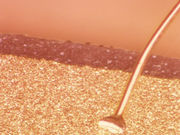Single dose of ultraviolet radiation after intense pulsed light does not amplify side effects
FRIDAY, Aug. 5, 2016 (HealthDay News) — Darker skin pigmentation and increasing intense pulsed light (IPL) fluence determine side effects after IPL exposure, according to a study published online July 30 in Lasers in Surgery and Medicine.
In a study involving 16 healthy subjects with Fitzpatrick skin types (FSTs) II to V, Daniel Thaysen-Petersen, M.D., from the University of Copenhagen in Denmark, and colleagues examined the contribution of skin pigmentation, fluence level, and ultraviolet radiation (UVR) on IPL-induced side effects. Three test areas were separated into four sites and randomly allocated to a single IPL exposure of 22, 34, and 46 J/cm² or triple stacking of 46 J/cm²; subsequently, areas were randomized to no UVR or single solar-simulated UVR exposure. Each area had a corresponding control. Patients were followed for up to four weeks after IPL.
The protocol was completed by 15 subjects with FSTs II to IV. The researchers found that IPL induced a range of skin reactions, including erythema (87 percent), hyper- and hypopigmentation (60 and 20 percent, respectively), purpura (27 percent), blisters (20 percent), edema (13 percent), and crusting (13 percent). Determinants for IPL-induced side effects included darker skin pigmentation and increasing IPL fluence (P ≤ 0.002); side effects were not exacerbated with single exposure of UVR (P ≥ 0.180).
“Skin pigmentation and IPL fluence are major determinants of side effects after IPL exposure,” the authors write.
Several authors disclosed financial ties to The Proctor & Gamble Company, which funded the study.
Copyright © 2016 HealthDay. All rights reserved.








